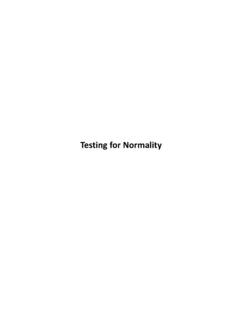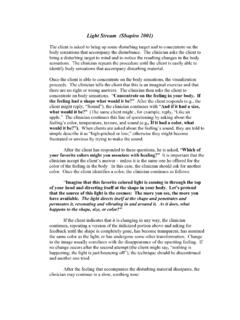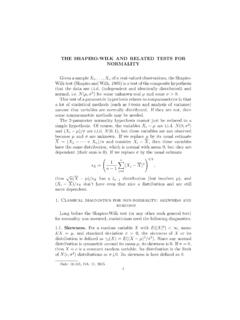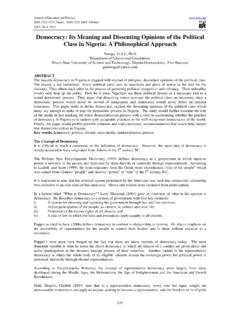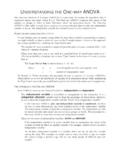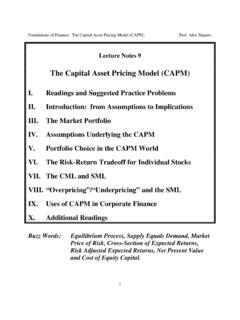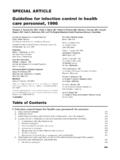Transcription of GLOSSARY OF INDUSTRIAL ORGANISATION ECONOMICS …
1 GLOSSARY OF INDUSTRIALORGANISATION ECONOMICSAND COMPETITION LAW- ORGANISATION FOR ECONOMIC CO-OPERATION ANDDEVELOPMENT2 FOREWORDThe Centre for Co-operation with European Economies in Transition,created in March 1990, is the focal point for co-operation between the OECD andcentral and eastern European countries and the former Soviet republics. Its majorresponsibility is to design and manage a programme of policy advice, technicalassistance and training which puts the expertise of the Secretariat and Membercountries at the disposal of countries engaged in economic December 1990, the Council adopted a programme "Partners inTransition" for the purpose of providing more focused assistance to those countriesthat are more advanced in introducing market-oriented reforms and desire tobecome members of OECD.
2 Additional activities which the Centre co-ordinatesunder this programme include reviews of the country s economic situation andprospects; reviews of specific policy areas and the participation of the Partnercountries in a number of OECD all these activities, the Centre maintains close relations with othermultilateral bodies with the mutual objective of ensuring the complementarity ofrespective efforts to support economic reforms in Central and Eastern Europe andthe former Soviet GLOSSARY of INDUSTRIAL ORGANISATION ECONOMICS and Competition Lawhas been commissioned by the Directorate for Financial, Fiscal and EnterpriseAffairs in the framework of the Centre s work programme, to assist officials,academics and policy makers in the reforming central and eastern Europeaneconomies in their understanding of the basic concepts of modern GLOSSARY has been compiled by R.
3 S. Khemani, Adjunct Professor at theFaculty of Commerce and Business Administration, University of BritishColumbia, B. C., Canada and D. M. Shapiro, Principal, School of Community andPublic Affairs, Concordia University, Montreal GLOSSARY is published on the responsibility of the Secretary-General ofthe OECD. Salvatore Zecchini Director of the Centre for Co-operation with the European Economies in Transition4 Index of TermsTerms in bold type are defined and discussed in this GLOSSARY . Those initalics are cross-referenced or incorporated in the discussion of other related termsand concepts. (The column of figures below right indicates the corresponding termin the French version of the GLOSSARY ).
4 Of Dominant Concentration (See Concentration).. Efficiency (See Pareto Efficiency).. Costs (See Opportunity Costs).. (See Merger).. Policy (See Antitrust).. Costs (See Costs).. to Point (Nash) Competition (Inter- and Intra-).. Concentration (See Concentration).. , (See Cartel, Collusion, Monopolization).. bidding (tendering) (See Bid Rigging).. Control (See Control of Enterprises, Holding5 Company).. Licensing (See Licensing).. Measures (See Concentration Indexes).. Ratio (See Concentration Indexes).. Action or Practice (See Cartel, Collusion).. Merger (See Merger).. Returns to Scale (See Economies of Scale).. Markets (See Contestability).. of Power (See Bilateral Monopoly,Buyer Concentration, Monopsony).. (Nash) Cartel (See Cartel).. Price Elasticity of Welfare Pricing (See Basing Point Pricing).
5 (See Anti-Monopoly Policy, Antitrust,Deconcentration).. Cartel (See Cartel).. (See Regulation).. Competition (See Cut-Throat Competition).. Products (See Product Differentiation).. (See Price Discrimination).. of Scale (See Economies of Scale).. s Mark (See Trade Mark).. Market Position (See Dominant Firm).. Price Leadership (See Dominant Firm, PriceLeadership).. of of of Demand (Price).. (See Concentration Indexes).. Competition (See Cut-Throat Competition).. Dealing (See Vertical Restraints).. Economies/Diseconomies (See Externalities).. Costs (See Costs).. of Competition (See Anticompetitive Practices).. Rider or Cost Forcing (See Tied Selling).. s Agreement (See Collusion).. Coefficient (See Concentration Indexes).. Index (See Concentration Indexes).. Products (See Homogenous Products, ProductDifferentiation).
6 Integration (See Merger).. Mergers (See Merger).. Elasticity of Returns to Scale (See Economies of Scale).. Concentration (See (See Vertical Integration).. Property and Intra-Brand Competition (See Brand Competition).. Cartel (See Cartel).. Index (See Concentration Indexes).. Monopoly Profits (See Joint Profit Maximization).. Profit Buyout (See Buyout).. Curve (See Concentration Indexes).. Buyout (See Buyout).. Cost (See Costs).. Revenue (See Revenue).. Concentration (See Concentration).. for Corporate Power (See Market Power).. Rents (See Rent).. Externality (See Externalities).. (See Monopsony).. Costs (or Alternative Costs).. Concentration (See Concentration).. Tie-in (See Bundling).. Se Illegal (See Rule of Reason).. Externality (See Externalities).. of Facilities (See Barriers to Entry,Anticompetitive Practices).)
7 Cartel (See Cartel).. Surplus (See Deadweight Welfare Loss).. (See Rent).. or Suggested to Price Maintenance (RPM).. of Entry to the Market (See Barriers toEntry, Limit Pricing).. of Technology (See Licensing).. on on Competition (See Cut-Throat Competition).. of Best, Theory (See Regulation).. Concentration (See Concentration).. Below or Joint Lessening of Competition (See Market Power).. Monopoly (See Contestability).. Collusion (See Collusion, Conscious Parallelism).. costs (See Costs).. Delivered Pricing (See Basing Point Pricing).. Costs (See Costs).. Merger (See Merger).. Restraints (or Restrictions).. (See Efficiency, X-Inefficiency).. of Dominant PositionAnticompetitive business practices in which a dominant firm may engagein order to maintain or increase its position in the market.
8 These business practicesby the firm, not without controversy, may be considered as "abusive or improperexploitation" of monopolistic control of a market aimed at restricting competition. The term abuse of dominant position has been explicitly incorporated incompetition legislation of various countries such as Canada, EEC and Germany. In the United States, the counterpart provisions would be those dealing withmonopoly and attempts to monopolize or monopolization of a of the different types of business practices are considered as beingabusive will vary on a case by case basis and across countries. Some businesspractices may be treated differently in different jurisdictions as well. However, thebusiness practices which have been contested in actual cases in different countries,not always with legal success, have included the following: charging unreasonableor excess prices, price discrimination, predatory pricing, price squeezing byintegrated firms, refusal to deal/sell, tied selling or product bundling and pre-emption of facilities.
9 See Anticompetitive practices. See also I. Schmidt,"Different Approaches and Problems in Dealing With Control of Market Power: AComparison of German, European and Policy Towards Market-DominatingEnterprises", Antitrust Bulletin, Vol. 28, 1983, pp. 417-460. And, Scherer10and D. Ross, INDUSTRIAL Market Structure and Economic Performance, HoughtonMifflin Co., Boston, 1990, Ch. 12, especially pp. to obtaining ownership and control by one firm, in whole or in part,of another firm or business entity. As distinct from a merger, an acquisition doesnot necessarily entail amalgamation or consolidation of the firms. Anacquisition, even when there is complete change in control, may lead the firmsinvolved to continue to operate as separate entities. Nevertheless, joint controlimplies joint profit maximization and is a potential source of concern to antitrustauthorities.
10 See also PricesAdministered prices are prices set by firms that do not vary in response toshort-run fluctuations in demand and supply conditions. This price rigidity hasbeen viewed by some economists as arising from the exercise of market power. Various research studies have been conducted attempting to link administeredprices to concentration and inflation. What emerges from the findings is thatthere are differences across industries (and across countries) in the degree of priceflexibility which simple models of market clearing cannot fully explain. However,researchers have been confronted with serious measurement difficulties, notablythe fact that official price indices often do not reflect price discounts. For furtherdetails, see Carlton, "The Theory and the Facts of How Markets Clear", in and R.










